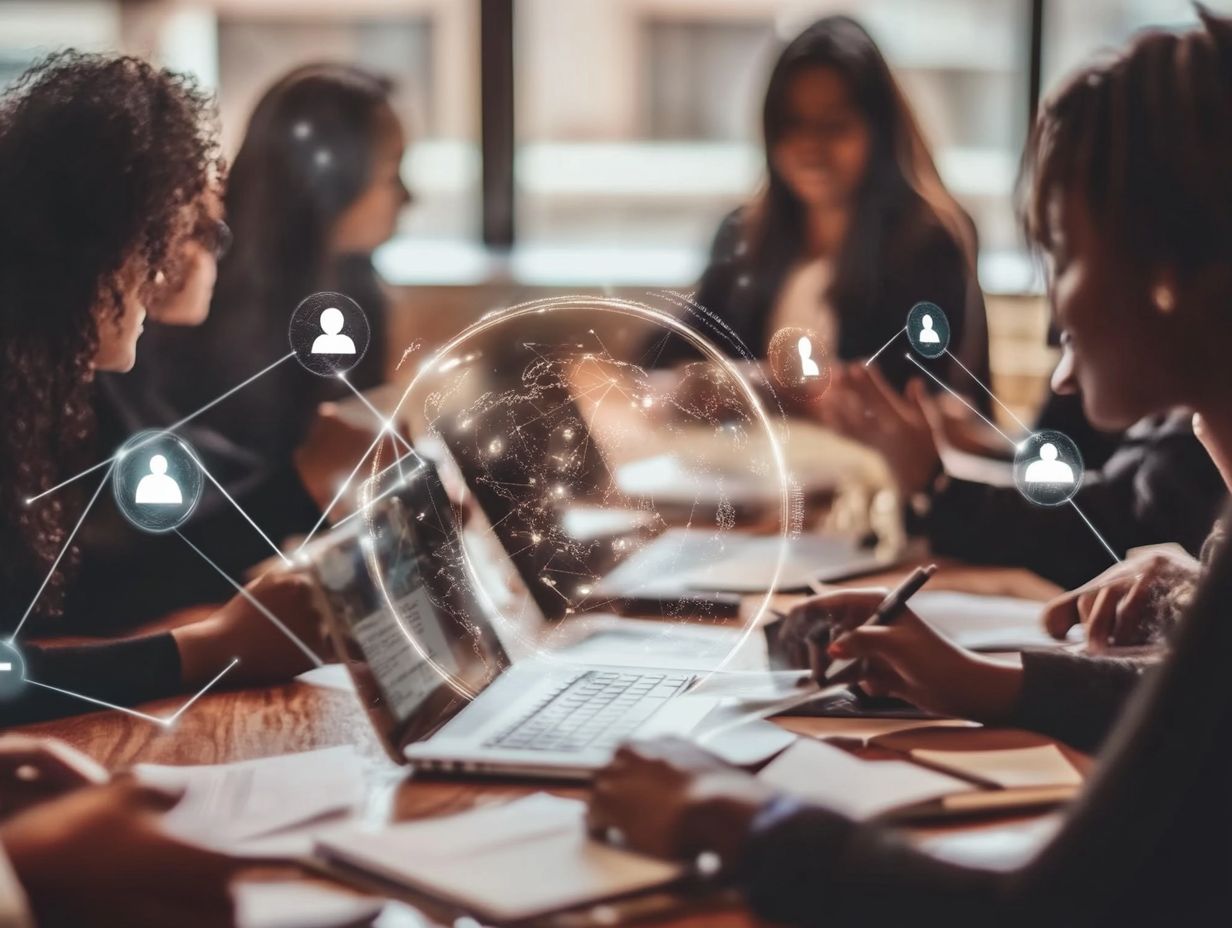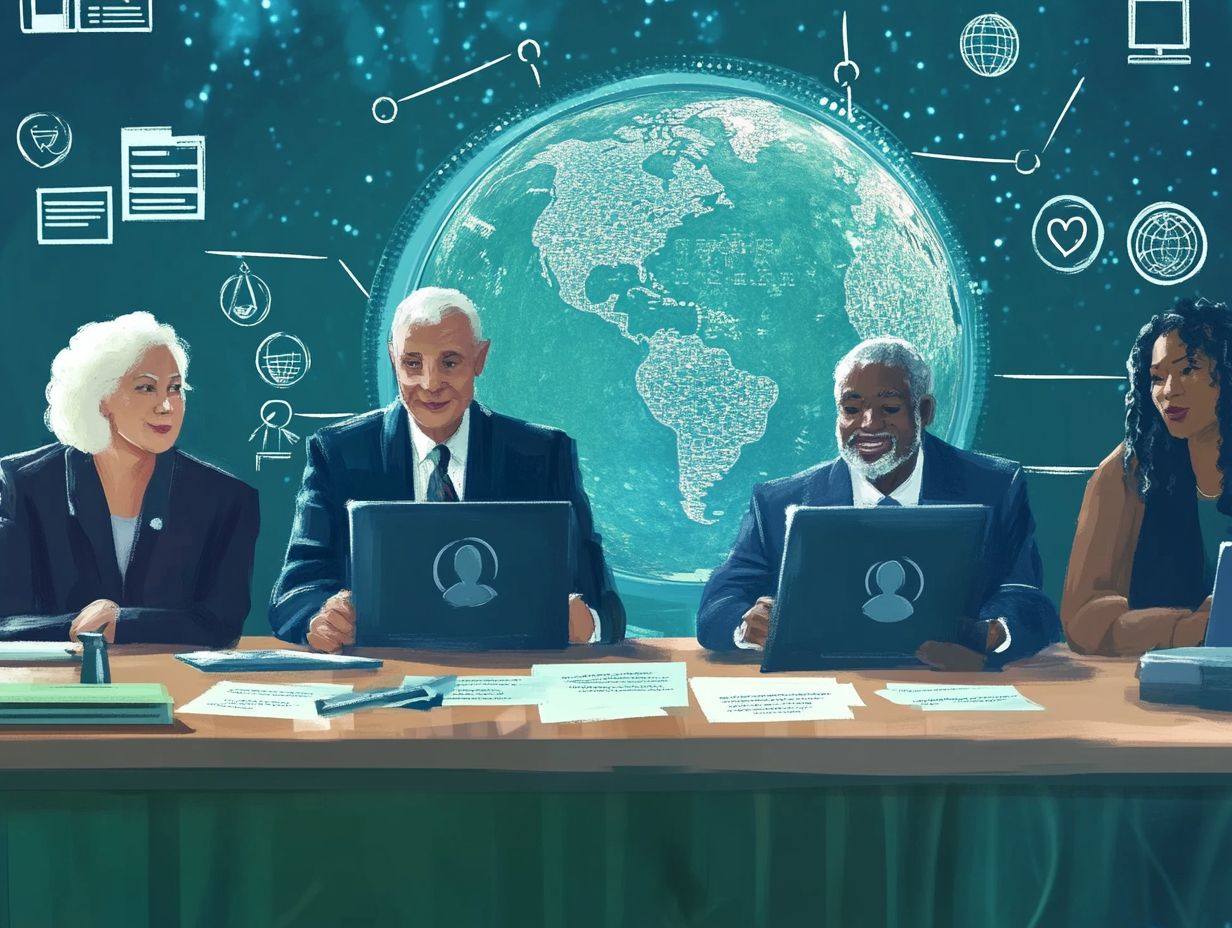The Role of Social Media in International IP Law
In today s digital landscape, social media and international intellectual property (IP) law converge significantly. Navigating the complexities of protecting your ideas online can be challenging. Understanding the basics of IP law is essential.
This article delves into the fundamentals of intellectual property, examining how it is safeguarded across borders and the unique challenges that social media platforms present. You ll uncover real-world case studies, discover best practices for protecting your IP, and gain insights into the future dynamics of IP law in our increasingly interconnected world.
Join us now as we dive into this vital topic and empower your success in the digital age!
Contents
- Key Takeaways:
- The Basics of International IP Law
- The Impact of Social Media on International IP Law
- Case Studies: Social Media and IP Law
- Best Practices for Protecting IP on Social Media
- The Future of International IP Law in the Age of Social Media
- Frequently Asked Questions
- Q1: What is the role of social media in international IP law?
- Q2: How does social media impact international IP law?
- Q3: Can social media be used as evidence in international IP law cases?
- Q4: How can social media be used to protect intellectual property rights internationally?
- Q5: What are the potential risks of using social media for international IP law purposes?
- Q6: How can businesses and creators stay compliant with international IP law on social media?
Key Takeaways:

- Social media presents both challenges and opportunities for businesses.
- Best practices for protecting your IP on social media are essential.
- The constantly evolving landscape of social media impacts international IP law, making it crucial to stay informed and adapt.
The Basics of International IP Law
International IP law encompasses a rich tapestry of regulations designed to safeguard intellectual property rights across borders. This includes copyright, trademark, and trade dress (the visual appearance of a product or its packaging) laws that clearly delineate content ownership and protection.
As digital content crosses borders with increasing frequency, grasping these laws becomes essential for creators and businesses pursuing global marketing strategies.
Legal frameworks, such as the Digital Millennium Copyright Act, significantly influence the compliance standards that dictate content sharing on various media platforms. This ensures consumer protection and alignment with international agreements.
What is Intellectual Property?
Intellectual property encompasses the creations of your mind think inventions, literary and artistic works, designs, symbols, names, and images that you use in commerce. These creations are safeguarded by copyright, trademark, and trade secret laws.
Understanding these protections is crucial for your business to thrive in competitive markets. Copyrights protect your creative works, such as books, music, and films, allowing you to reap financial rewards from your ingenuity.
Meanwhile, trademarks secure your brand identity through logos and slogans. Consider the iconic swoosh of Nike or the golden arches of McDonald’s; these symbols evoke immediate brand recognition.
Such protections enhance brand awareness and build consumer trust, making it essential to secure your intellectual property rights as a fundamental element of your business strategy.
How is it Protected Internationally?
International protection of intellectual property is facilitated through treaties and agreements, such as the Berne Convention for copyright and the Madrid Protocol for trademark rights. These frameworks establish compliance standards for member countries, ensuring the safeguarding of IP rights.
These systems cultivate a cohesive environment for enforcing intellectual property and empower you to navigate the complexities of global markets with confidence. By adhering to international treaties, you can ensure that your innovations are protected on a broader scale, effectively minimizing the risk of infringement and bolstering your competitive advantage.
It’s essential to recognize that local laws can vary significantly, necessitating a deep understanding of each jurisdiction s specific compliance requirements. This dual approach leveraging international treaties while remaining vigilant about local regulations enables you to craft robust protection strategies for your intellectual properties.
The Impact of Social Media on International IP Law

Social media platforms have profoundly reshaped intellectual property law, offering a complex blend of challenges and opportunities for you as a content creator or business.
In this digital age, navigating the intricacies of copyright and trademark infringement requires a keen understanding of the evolving landscape.
Challenges and Opportunities
The rise of social media presents a dual-edged sword, filled with both challenges and opportunities. As you manage who can share your content, you also aim to maximize brand exposure through influencer marketing and promotional campaigns.
In this dynamic landscape, unauthorized use of copyrighted material can pose significant risks to your brand identity and intellectual property. Misappropriation can quickly erode consumer trust and dilute your brand s integrity, compelling you to rethink your engagement strategies.
Savvy brands like yours can strategically collaborate with content creators to secure the necessary permissions, transforming potential pitfalls into opportunities. By leveraging targeted campaigns that emphasize authenticity, you can enhance brand loyalty and cultivate deeper connections with your audience, turning challenges into pathways for greater visibility and community engagement.
Case Studies: Social Media and IP Law
When you delve into case studies that explore the intersection of social media and intellectual property (IP) law, you uncover the legal challenges associated with copyright infringement and trademark rights. Copyright protects original works like videos and music, while trademark protects brand names and logos.
This complexity becomes particularly evident in the realm of social media influencers and the promotional content they produce. Understanding these nuances is essential for navigating the evolving landscape of digital marketing and protecting creative assets.
Examples of Legal Issues and Resolutions
Several high-profile legal cases ranging from copyright infringement involving user-generated content on platforms like YouTube to trademark disputes with social media influencers illustrate the intricate landscape of IP law in the realm of social media.
Take, for example, the landmark case of Viacom v. YouTube, which highlighted the contentious issues surrounding fair use. Viacom accused YouTube of facilitating unlawful uploads of its shows. In a pivotal moment, the court sided with YouTube, establishing a precedent that strengthened the platform’s policies on user-generated content.
Such rulings are crucial in shaping how content is shared online. They influence the community guidelines set forth by social media networks and delineate the rights users have in creating and sharing media.
The ongoing friction between influencers and brands regarding trademark usage has sparked vital conversations about clearer regulations. This dialogue ultimately leads to more comprehensive policies, ensuring that creators are well-informed about their rights and responsibilities when posting branded content.
Best Practices for Protecting IP on Social Media

Establishing best practices for protecting intellectual property on social media is crucial for you as a business or creator.
This involves implementing effective policies on social media, defining clear permissions for users, and developing a strong engagement strategy.
By doing so, you can navigate the landscape with confidence and avoid potential legal traps.
Tips for Businesses and Creators
You can employ several effective strategies to protect your intellectual property on social media. Start by understanding the specific policies of each platform, utilizing copyright registration, and being proactive about obtaining user permissions for content sharing.
Familiarizing yourself with the guidelines of each platform is crucial, as these rules dictate how your content can be used and shared. Some platforms offer built-in tools for reporting infringement or managing rights, which can be invaluable. Registering your copyrights gives you a robust legal foundation in case of disputes.
Clear communication about permissions can go a long way in preventing misunderstandings. Many brands successfully use custom licensing agreements to ensure that all parties involved are on the same page. By taking these proactive steps, you can safeguard your work and maintain your reputation in an ever-evolving digital landscape.
The Future of International IP Law in the Age of Social Media
The future of international IP law in the social media age is uncertain, and we must stay informed. You may find that potential changes are looming as lawmakers navigate the complexities of evolving advertising regulations while striving to safeguard IP rights in our increasingly digital world.
Predictions and Potential Changes
Experts predict that changes in social media regulations will impact your rights over your creations. This will reshape how you interact with your audience and protect consumers online.
As these changes unfold, the landscape for creators will transform. You must maintain heightened awareness and take proactive steps to safeguard your original works.
Your business needs to adapt its strategies to comply with new guidelines while staying competitive. This impacts everything from your marketing tactics to your content creation processes.
You and other consumers will face both advantages and challenges. Access to diverse content might be moderated by these regulations.
Therefore, you must stay informed to protect your rights in this changing landscape. This underscores the need for a vigilant approach to protecting your creations in an increasingly intricate digital environment.
Frequently Asked Questions

Social media plays a significant role in shaping international IP law. It has become a platform for businesses, creators, and individuals to connect, share, and protect their rights over their creations.
Social media has accelerated the spread of information, making it easier for infringement to occur. It also provides a platform for businesses and individuals to enforce their rights and prevent unauthorized use or distribution of their works.
Yes, social media content can serve as valuable evidence in IP law cases. It can prove ownership, infringement, or damages in cases involving copyright, trademarks, and patents.
Social media is a tool to monitor, detect, and report potential infringements. It allows businesses and creators to build an online presence and establish a strong brand, which can deter infringement.
While social media is useful for protecting IP rights, it also presents risks. These include the possibility of confidential information being leaked, the spread of false information, and unauthorized use of copyrighted material, highlighting the importance of understanding the role of IP lawyers in international cases.
To stay compliant with IP law on social media, understand the laws of the countries in which you operate. Have clear guidelines for using and sharing content, and regularly monitor for potential infringements.
We encourage you to share your experiences with social media and IP law in the comments below!






